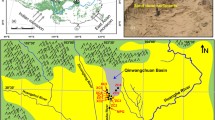Abstract
Eolian loess is widely distributed on the various geomorphic surfaces between 700–2400 m a.s.l. on the northern slope of the Tian Shan. It is formed in a synchronous manner with dust transported from the Gurbantunggut Desert in the Junggar Basin. The thickest section of loess was found in the Shawan and Shihezi regions. Paleomagnetic and climatic proxy analyses of over 71 m of a loess-paleosol sequence on the highest terrace of the Qingshui He (River) in the Shawan show that the paleomagnetic Bruhues/Matuyama (B/M) boundary lies at the bottom of paleosol S8, at a depth of 69.5 m, and the bottom of the sequence was estimated to be ∼0.8 Ma. This implies that the extremely dry climatic conditions in the Junggar Basin and the initial Gurbantunggut Desert were present at least by 0.8 Ma. High-resolution grain size series demonstrate that this area and desert expansion experienced two dramatic periods of desert expansions that occurred at ∼0.65 Ma and 0.5 Ma, respectively; and the subsequent continuous enhancement led to the environment presently observed. This tremendous environmental effect, caused by large-scale expansion of the desert and arid region of inner Asia, might be an important driving force for the global temperature drop that occurred in the mid-Pleistocene.
Similar content being viewed by others
References
Andreae, M. O., Climate effects of changing atmospheric aerosol levels, World Survey of Climatology, Future Climates of the World, Volume 16 (eds. A. Henderson and A. Sellers), Amsterdam: Elsevier, 1995, 341–392.
Harvey, L. D. D., Climatic impact of ice-age aerosols, Nature, 1988, 334: 333.
Martin, J. H., Glacial-interglacial CO2 change: the iron hypothesis, Paleoceanography, 1990, 5: 1.
Shine, K. P., P. M. de F. Forster, The effect of human activity on radiative forcing of climate change: a review of recent developments, Global and Planetary Change, 1999, 20: 205.
Zhang, X. Y., Arimoto, R., An, Z. S., Dust emission from Chinese desert sources linked to variations in atmospheric circulation, J. Geophys. Res., 1997, 102: 28041.
Duce, R. A., Liss, P. S., Merrill, J. T. et al., The atmospheric input of trace species to the world ocean, Global Biogeochemical Cycles, 1991, 5: 193.
Rea, D. K., The paleoclimatic record provided by eolian deposition in the deep sea: the geologic history of the wind, Reviews of Geophysics, 1994, 32: 159.
Biscaye, P. I., Grousset, F. E., Revel, M. et al., Asian provemance of glacial dust (stage 2) in the Greenland Ice Sheet Project 2 Ice Core, Summit, Greenland, J. Geophys. Res., 1997, 102: 26765.
Zhang, X. Y., Arimoto, R., An, Z. S., Glacial and interglacial patterns for Asian dust transport, Quat. Sci. Rev., 1999, 18: 811.
Dong, G. R., Jing, J., Gao, S. Y. et al., The Climate Change in North China Deserts since Late Pleistocene, Quat. Sci. Res. (in Chinese), 1990, 3: 213.
An, Z. S., The Quaternary Loess Geology and Global Change (2) (in Chinese), Beijing: Sci. Press, 1990.
Sun, J. M., Ding, Z. L., Liu, T. S. et al., Desert distributions during the glacial maximum and climate optimum: example of China, Episodes, 1998, 21: 28.
Li, J. J., Fang, X. M., Uplift of Qinghai-Tibetan Plateau and Environmental change, Chin. Sci. Bull., 1998, 44 (23): 2217.
Sun, D. H., Liu, T. S., Cheng, M. Y. et al., Magnetostratigraphy and paleoclimate of red-clay sequences from the Chinese Loess Plateau, Sci. in Chin., Ser. D, 1997, 40: 337.
Ding, Z. L., Sun, J. M., Yang, S. L. et al., Preliminary magnetostratigraphy of a thick eolian red clay-loess sequence at Lingtai, the Chinese Loess Plateau, Geophys. Res. Lett., 1998, 25: 1225.
Guo, Z. T., Peng, S. Z., Hao, Q. Z. et al., The Relation between the development of arid NW China and ice cover in the North Pole and the uplift of the Tibetan Plateau in Late Tertiary, Quat. Sci. Res. (in Chinese), 1999, 6: 556.
An, Z. S., Kutzbach, J. E., Prell, W. L. et al., Evolution of Asian monsoon and phased uplift of the Himalaya-Tibetan plateau since late Miocene times, Nature, 2001, 411: 62.
Fang, X. M., Lü, L. Q., Yang, S. L. et al., Loess in Kunlun Mountain and its implications on desert development and Tibetan Plateau uplift in West China, Sci. in Chin., Ser. D, 2002, 45: 289.
Pan, B. T., Wu, G. J., Wang, Y. X. et al., Age and genesis of the Shagou River terrace in eastern Qilian Mountains, Chin. Sci. Bull., 2001, 46(6): 509.
Zhang, J. B., Deng, Z. F., Outline of Xinjiang Precipitation (in Chinese). Beijing: Meteor. Press, 1987.
Obuluchv, B. A., Loess on the northwest Junggar Basin, Geol. Trans. (in Chinese), 1956(8): 8.
Liu, T. S. et al., Loess Deposition in China (in Chinese), Beijing: Sci. Press, 1965.
Zhang, H. Y., Wang, H. Z., The loess stratigraphy on the north slope of Tian Shan and the paleoclimate, Arid Region-Xinjiang Quaternary Research Collection (in Chinese), Urumqi: Xinjiang People’s Press, 1985, 95–106.
Xinjiang Comprehensive Exploration Team of CAS, Xinjiang Quaternary Geology and Environment (in Chinese), Beijing: Science Press, 1995, 11–17, 56–67.
Champion, D. E., Lanphere, M. A., Evidence for a new geomagnetic reversal from lava flows in Idaho: discussion of short polarity reversals in the Brunhes and late Matuyama polarity chrons, J. Geophy. Res., 1988, 93: 11667.
Zhu, R. X., Kazansky, A., Matasova, G. et al., The loess magnetism of loess deposition in south Siberia, Chin. Sci. Bull. (in Chinese), 2000, 45 (11), 1200.
Li, J. J., Evolution of the Environment in northwest China since late Pleistocene, Quat. Sci. Rev. (in Chinese), 1990(3): 197.
Fang, X. M., Li, J. J., Van der Voo, R., Paleomagnetic/rockagnetic and grain size evidence for intensified Asian atmospheric circulation since 800 kyrs, Earth Planet Sci. Lett., 1999, 165: 129.
Author information
Authors and Affiliations
About this article
Cite this article
Fang, X., Shi, Z., Yang, S. et al. Loess in the Tian Shan and its implications for the development of the Gurbantunggut Desert and drying of northern Xinjiang. Chin. Sci. Bull. 47, 1381–1387 (2002). https://doi.org/10.1360/02tb9305
Received:
Issue Date:
DOI: https://doi.org/10.1360/02tb9305




